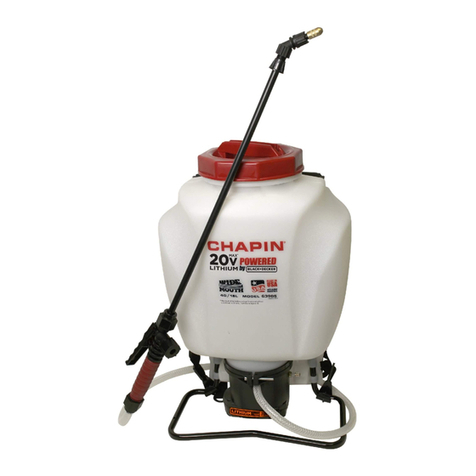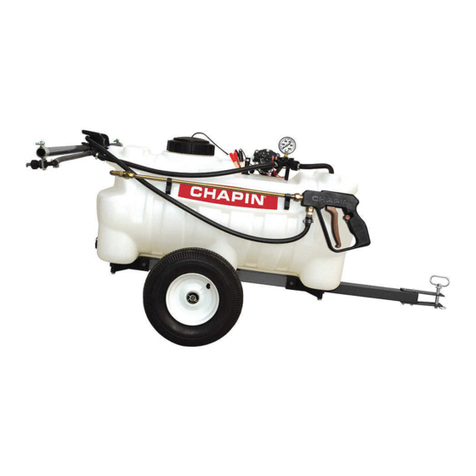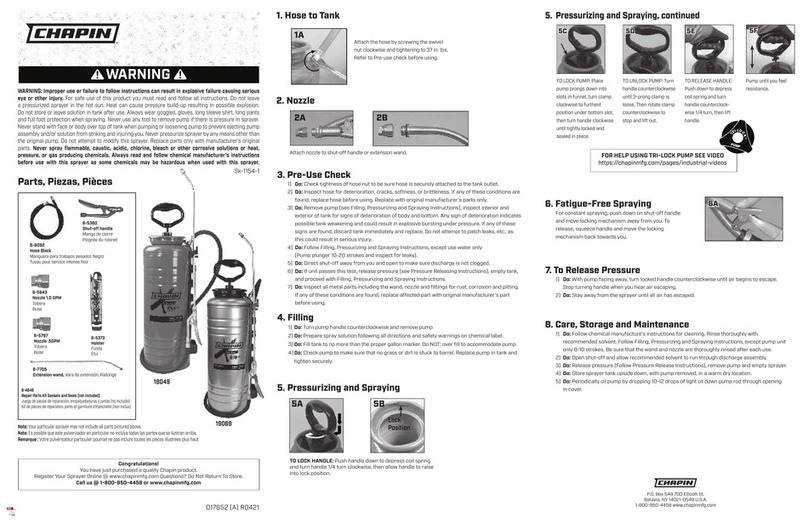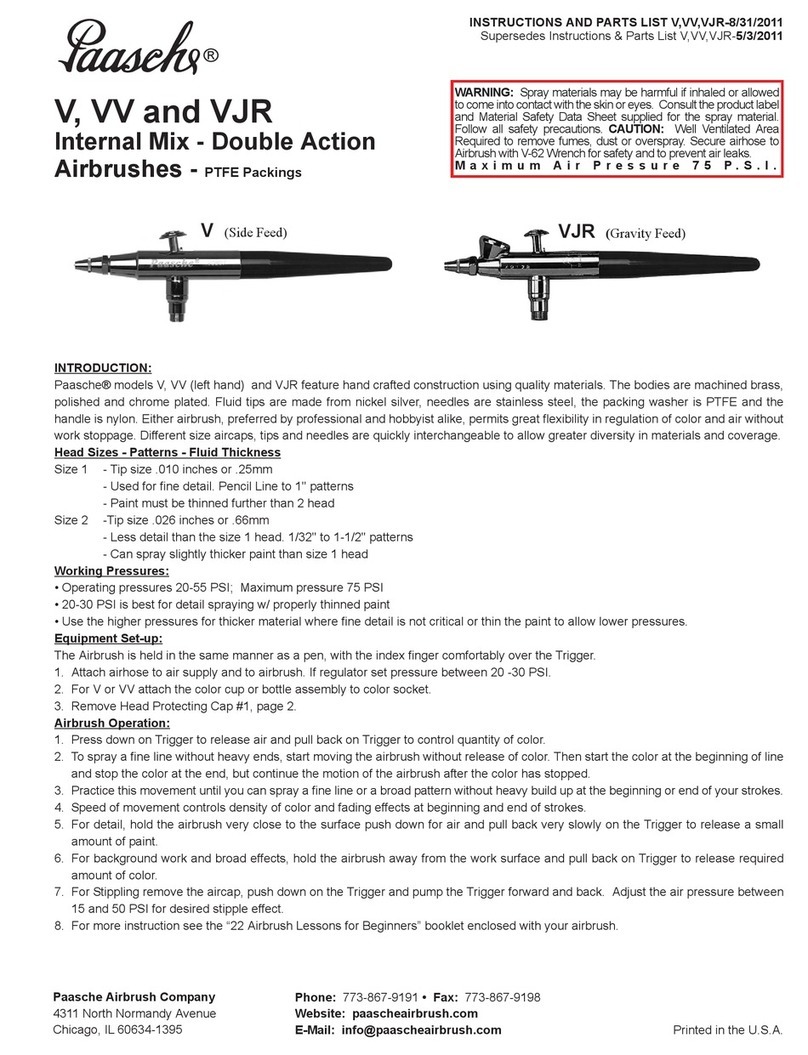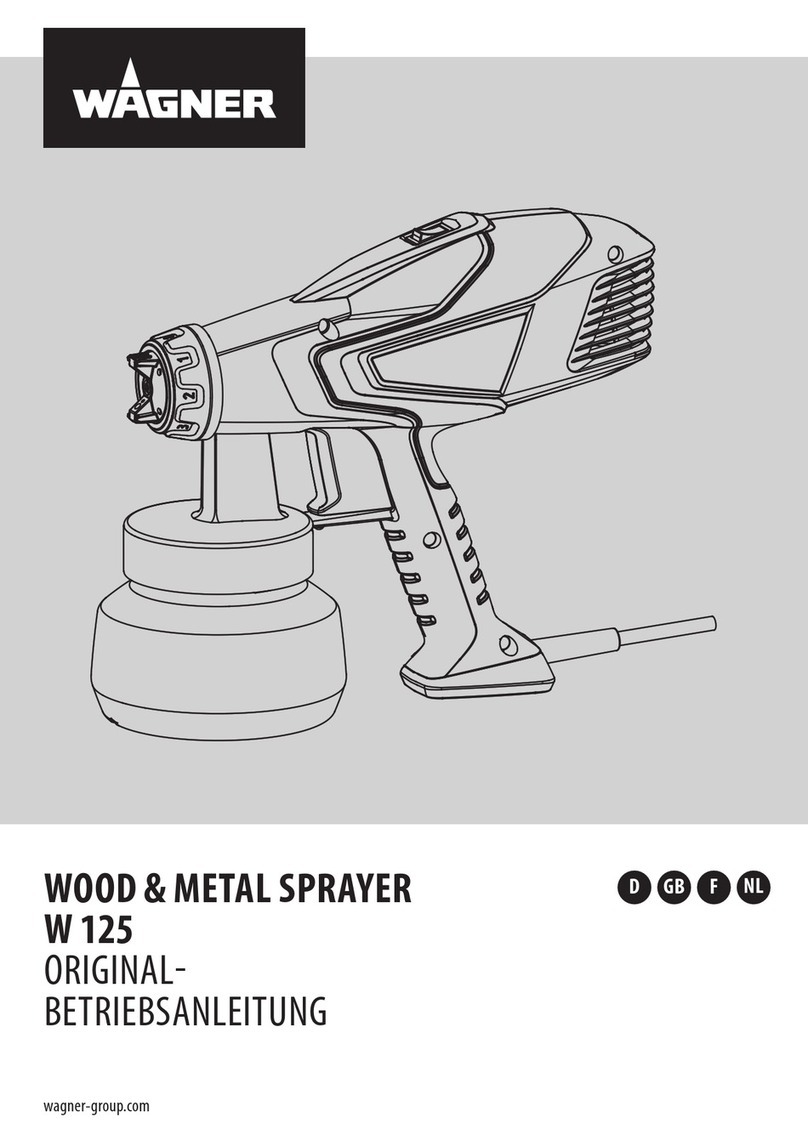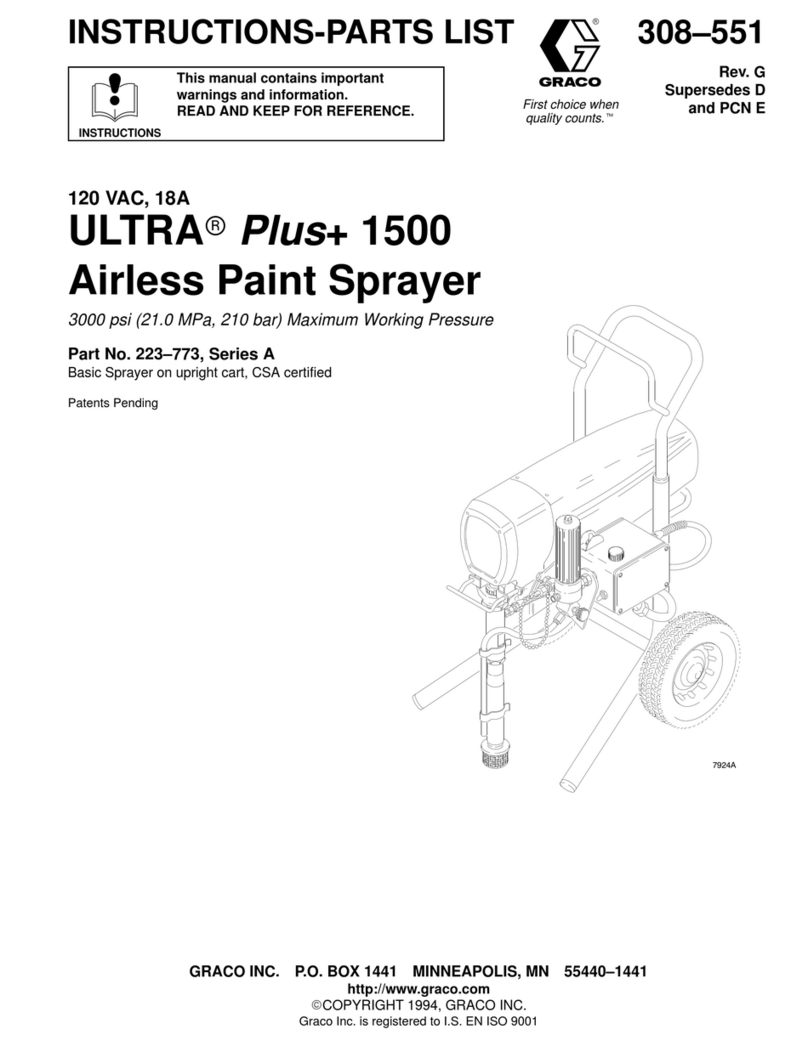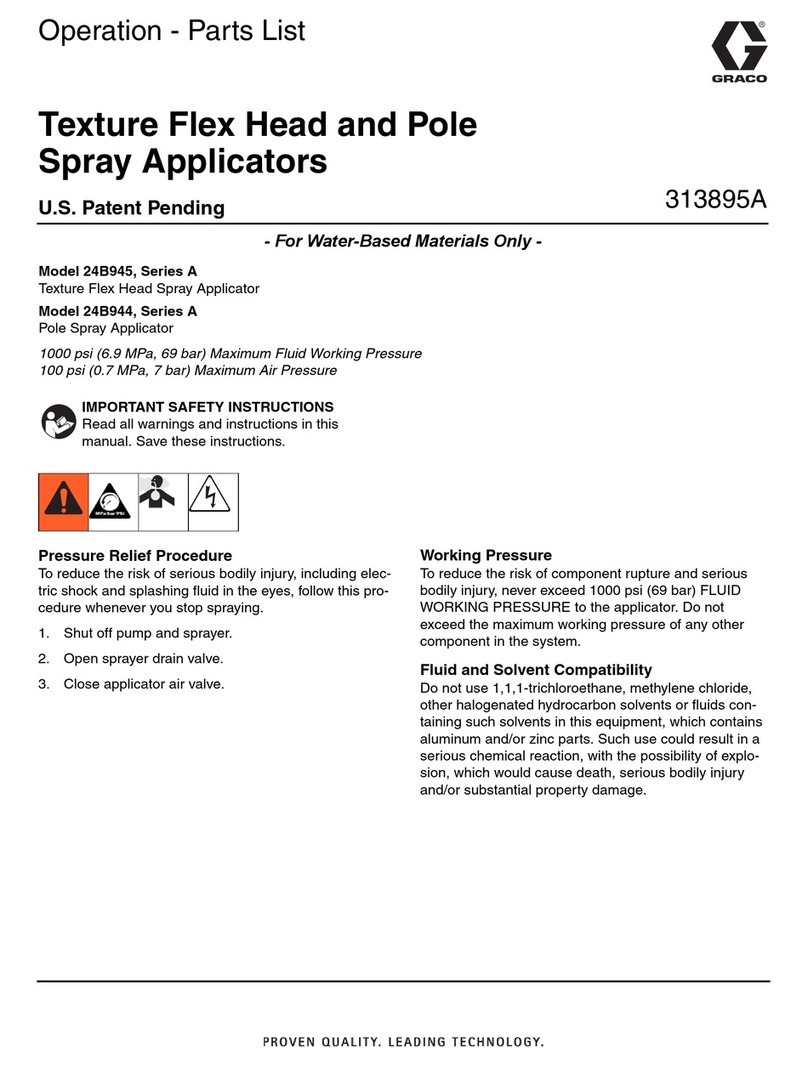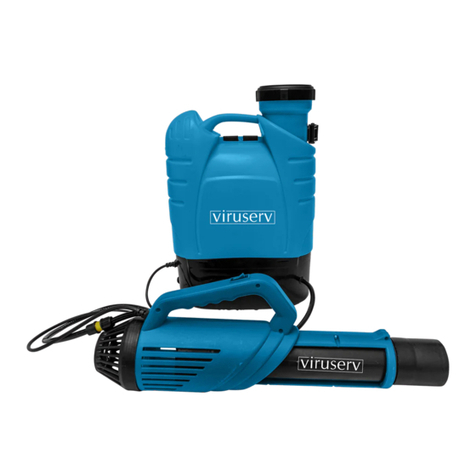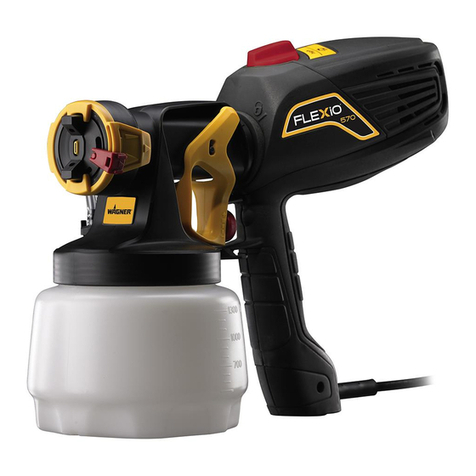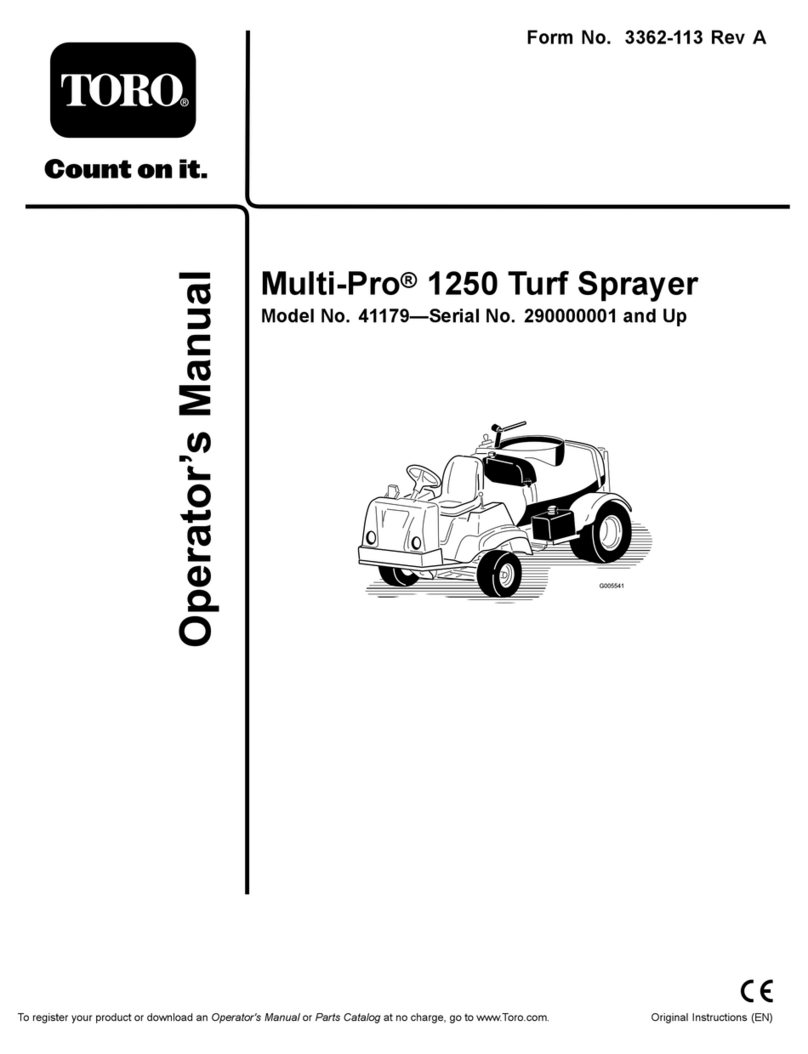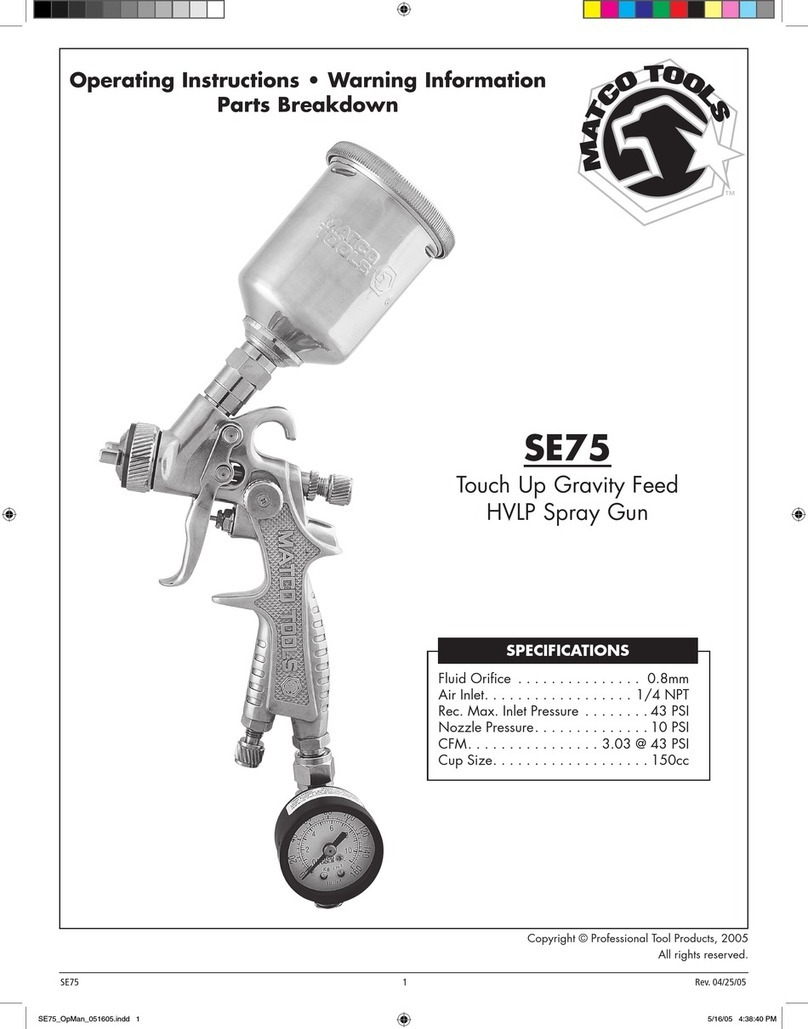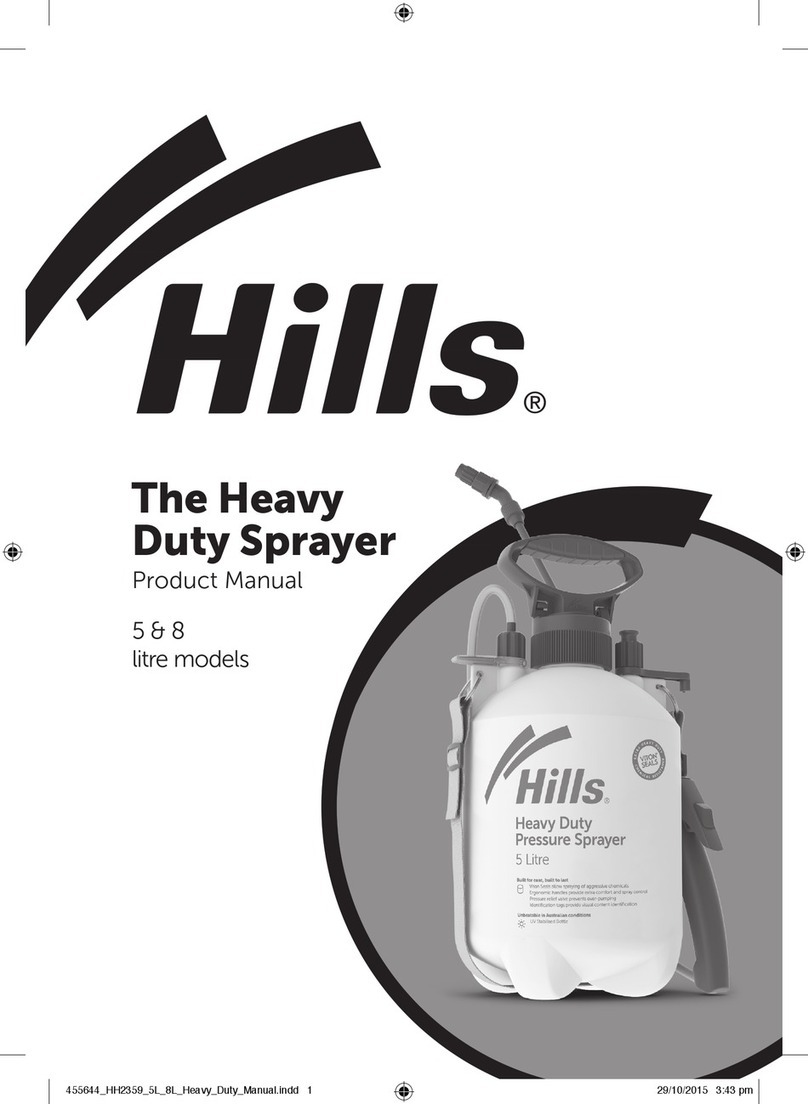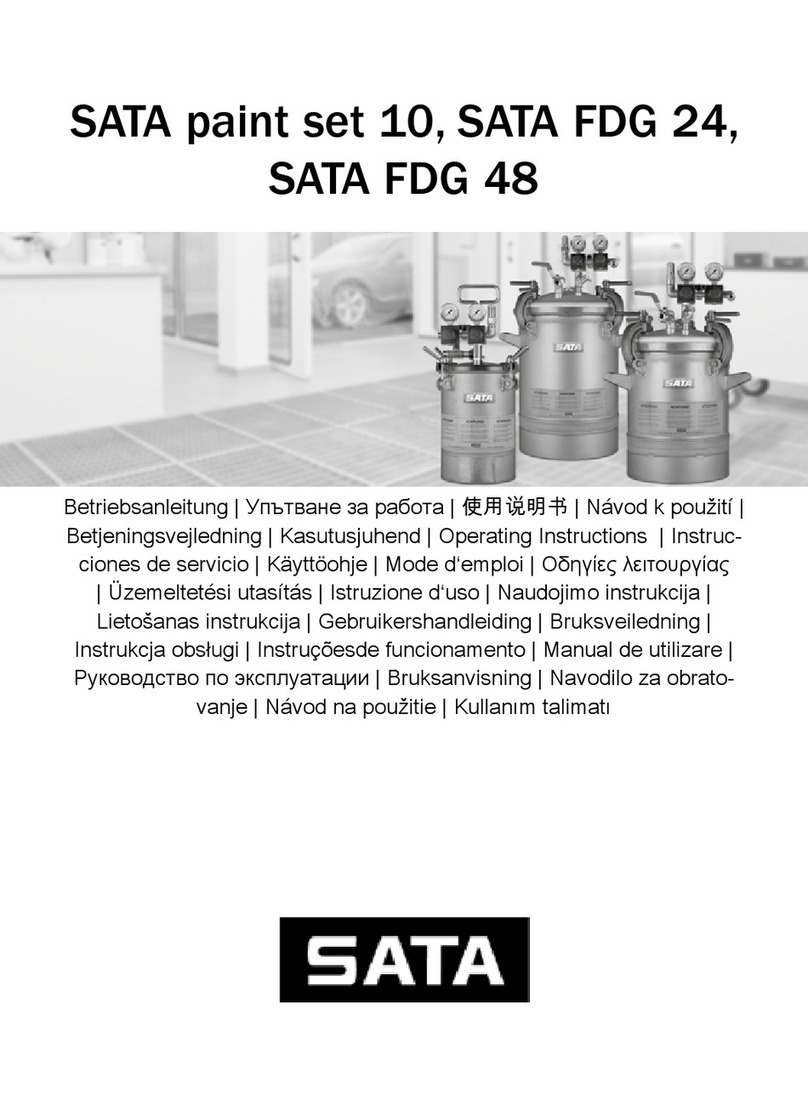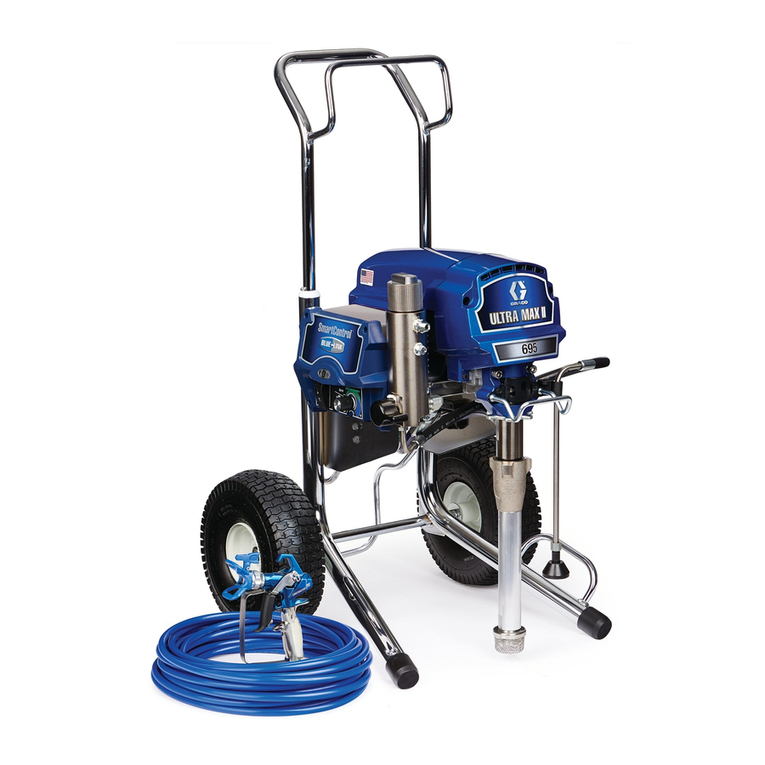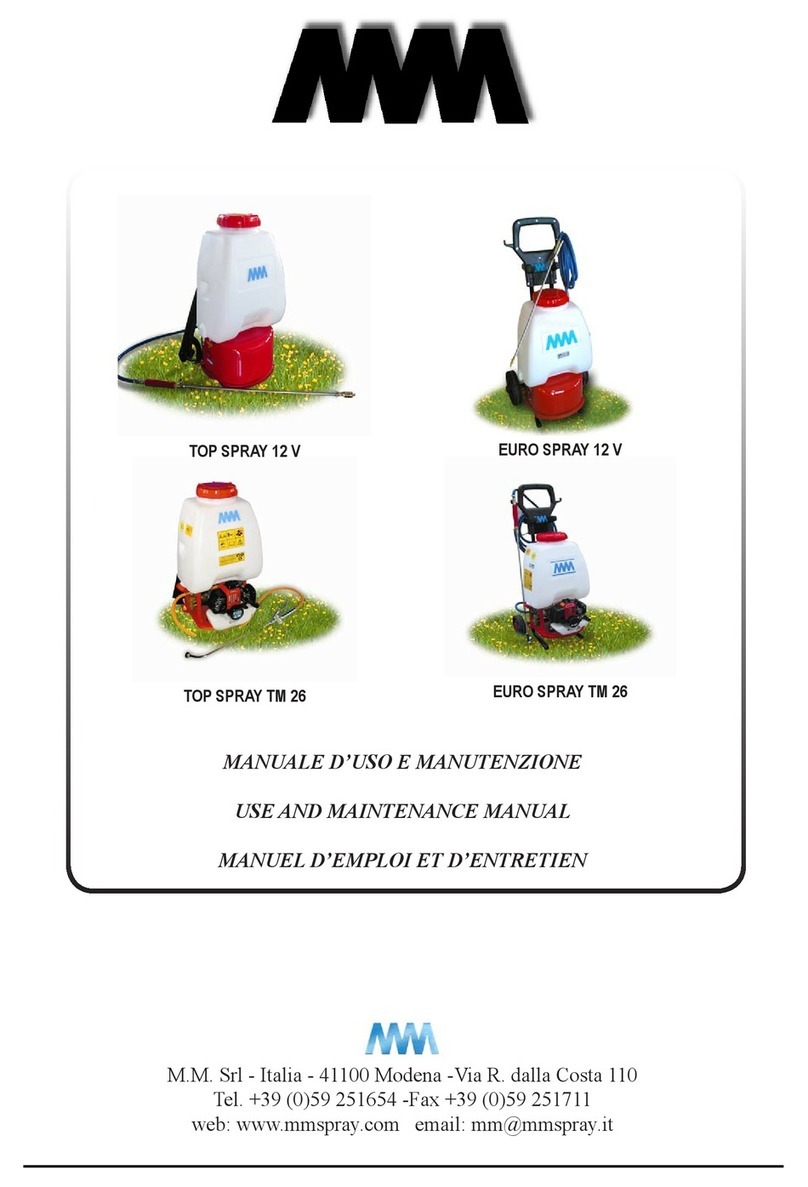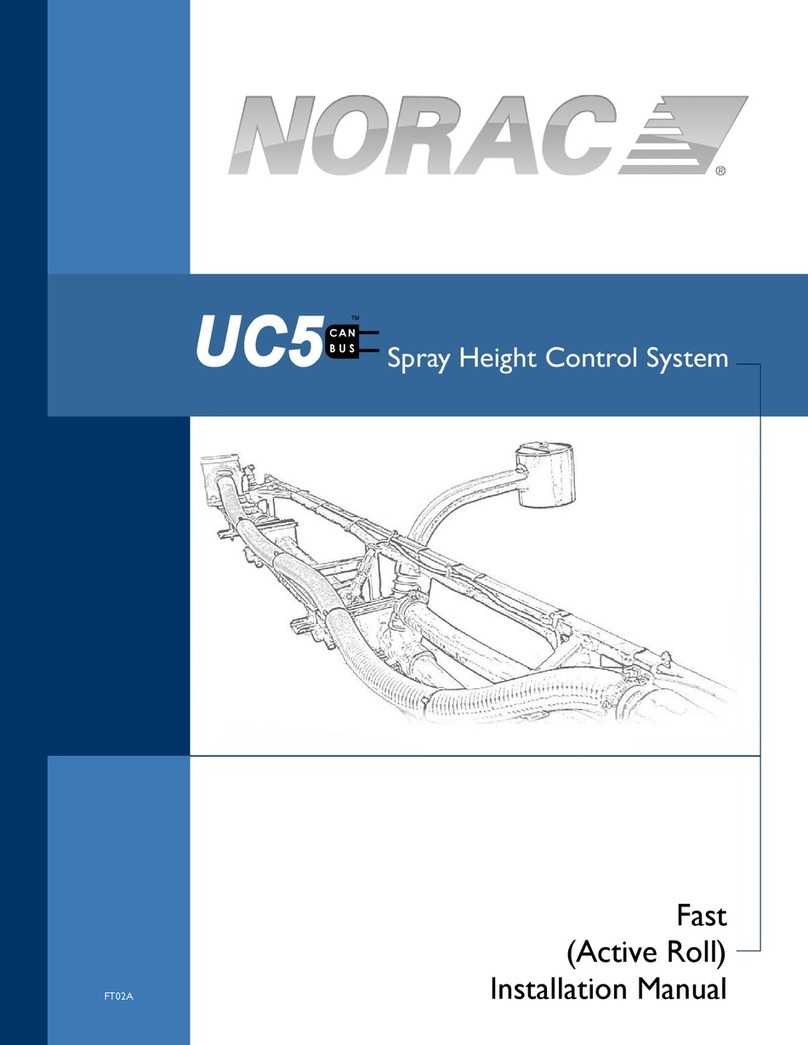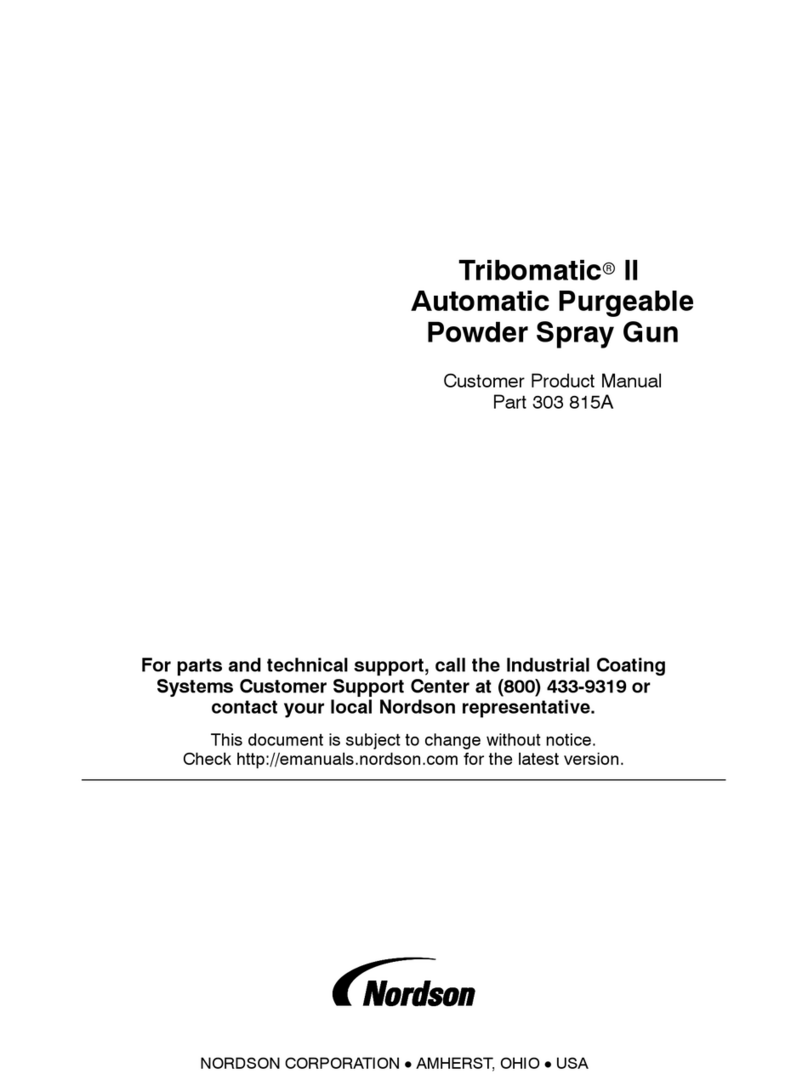Chapin 61950 User manual

Model 61950 • 4G/ 15L
011440 R0713
Carefully Read These Instructions Before Use
Chapin International, Inc
P.O. Box 549
700 Ellicott St.
Batavia, NY 14021-0549 U.S.A.
1-800-950-4458
www.chapinmfg.com
WARNING
DO NOT RETURN THIS
SPRAYER TO STORE
Call: 1-800-950-4458
www.chapinmfg.com
Use and Care Manual
BackpackBackpack
SprayerSprayer
Tree/Turf ProTree/Turf Pro

WARNING
WARNING: Handling the brass parts of this product will expose you to lead, a chemical
known to the State of California to cause birth defects and other reproductive harm.
Wash hands after handling.
CAUTION
1E
WARNING: Improper use or failure to follow instructions can result in explosive
failure causing serious eye or other injury. For safe use of this product you must read
and follow all instructions. Do not leave a pressurized sprayer in the hot sun. Heat can cause
pressure build-up resulting in possible explosion. Do not store or leave solution in tank after
use. Always wear goggles, gloves, long sleeve shirt, long pants and full foot protection when
spraying. Never use any tool to remove pump if there is pressure in the pressure chamber.
Never pressurize sprayer by any means other than the original pump. Do not attempt to
modify this sprayer. Replace parts only with manufacturer’s original parts. Never spray
ammable, caustic, acidic, chlorine, bleach or other corrosive solutions or
heat, pressure, or gas producing chemicals. Always read and follow chemical
manufacturer’s instructions before use with this sprayer as some chemicals may
be hazardous when used with this sprayer.
• PRE-USE CHECK: Before each use check tightness of hose nut to be sure hose is
securely attached to the shut-off assembly. Insure hose is securely attached to the
pump outlet by tightening hose nut. Insure that all nozzle and wand connections
are tight. Insure the three bolts (underside of base) used to attach the piston
cylinder are tight.
• Do Not exceed a tank solution temperature of 120º F/ 49º C.
NOTE: The tank and hose may have residual water in it due to quality testing
performed on the sprayer.
SK 1158-1

1. Poly
Nozzle Cap
2. Retaining
Nut
3. Nozzle
Body
4. Nozzle
Gasket
5. Elbow
Figure 3Figure 2Figure 1
1. Brass
Nozzle Cap
2. Retaining
Nut
3. Nozzle
Body
4. Nozzle
Gasket
5. Elbow
Nozzle
Gasket
Retaining Nut
Elbow
Fan Nozzle Tip
2E
APPLICATIONS & USE FOR YOUR SPRAYER
Avoid using a sprayer for general cleaning purposes if plant protection or herbicide chemicals have
already been used in the sprayer. If a sprayer has been used for plant protection or as an herbicide, clean
the sprayer completely (see cleaning section) before using.
Plant Food: Use different spray patterns for optimum foliage feeding or for fungicide and pesticide
application.
Herbicides: Reduce weeds and unwanted plants but avoid using the same sprayer for plant feeding or
protection without thoroughly cleaning (see cleaning section) the sprayer first.
General Household Use: Apply detergents, cleaning solutions, warm water (do not exceed
120°F/49°C) or nontoxic household cleaning chemicals for carpets, floors, walls, glass, counter tops and
ceilings. DO NOT use sprayer that has been used with herbicides, pesticides or other toxic chemicals for
household applications.
General Outdoor Use: Use the sprayer for cleaning windows or with a detergent for general purpose
cleaning.
SPRAYER COMPONENTS & USE INFORMATION
NOZZLE ASSEMBLY
Figure 1-2
Unscrew the nozzle cap (1) from the nozzle body (3) with retaining nut (2) fastened tightly to the elbow
(5). Unscrew the retaining nut (2). Push the nozzle body (3) with the nozzle gasket (4) out of the retaining
nut (2). To reinstall the nozzle, reverse the above instructions.
Figure 3
Unscrew the retaining nut from the elbow and push the fan nozzle tip and gasket out of the retaining nut. To
reinstall the nozzle, reverse the above instructions.
O-ring
Wand
Retaining Nut Shut-off
Valve
WAND ASSEMBLY
1. Make sure the o-ring is installed on the end of the wand. Insert the wand into shut-off valve.
2. Turn and tighten the retaining nut clock-wise onto the shut-off valve.

INSTALLING THE PUMP HANDLE
The pump handle can be mounted on either side of the pump shaft
(A). To install the pump handle place the handle (C) over the shaft
(A) aligning the pump handle hole and shaft hole. Push the straight
side of the cotter pin (B) through the aligned hole as shown in figure
1 thru 3. There are holes in the pump handle to allow for either
left(fig.4) or right (fig.5) hand mounting.
3E
SPRAYER COMPONENTS & USE INFORMATION, Continued
A
C
B
Figure 1
Cotter Pin
Figure 2
Line up holes
Figure 3
Slide pin through holes
Figure 4
Left Hand
Figure 5
Right Hand
Pump Handle
Positioned For Use
(right hand shown)
STOWAWAY PUMP HANDLE
Pull
up
Rotate
180º
Set
into
slot
INSTALLING THE
SHOULDER STRAP
The top of the shoulder straps
are attached to the tank.
Attach the lower end of the
straps by clipping the strap
hooks to the metal frame
between where the frame
exits the tank and curves
around.
WAND CLIP
The wand can be
attached to the
pump handle
using the wand
clip.

4E
Stage 3
(removable
Shut-off filter)
FILLING THE SPRAYER
Make sure the filter basket is in place to keep debris from entering the tank.
Determine the amount of mixture needed for your application. Add the proper amount of water to
the tank. Add the proper amount of chemical to the tank (check the chemical label for proper ratio of
chemical). Stir mixture in tank with a clean utensil (like a paint stirrer). The tank will hold the 4-gallon
(15.1L) capacity plus the chemical.
It is not necessary to completely fill the sprayer tank with each use. You can fill the tank with only the
amount needed for each application.
Always follow the manufacturer’s instructions included on their product label.
Figure 1 Stage 1
(Filter
basket)
3 STAGE FILTERING SYSTEM
Stage 2
(Removable
In-Tank Filter
Pressure
Cylinder
This backpack sprayer is equipped with a 3 stage filtering system (see figure
1). Stage 1 is a filter basket incorporated into the tank opening where fluid is
added. Stage 2 filter is located at the inlet of the pressure cylinder. Stage 2
is a removable In-Tank filter. Stage 3 is a removable filter incorporated into
the shut-off assembly. Periodic cleaning of these filters is recommended to
insure consistent fluid flow through the sprayer. This will also reduce sprayer
component wear.
The stage 3 filter is a removable filter incorporated into the inlet side of the
shut-off valve (see section “disassembling and repairing the shut-off valve”) .
Make sure pressure is released before detaching the hose from the shut-off.
It is best to have no or minimal fluid in the pressure cylinder before removing
and reinstalling the stage 3 shut-off filter as fluid can leak from the hose.
Figure 2 Stage 2 (removable In-Tank filter)
Guide edge facing away from
pressure cylinder Guide edge on pressure
cylinder
SPRAYER COMPONENTS & USE INFORMATION, Continued

5E
SPRAYER COMPONENTS & USE INFORMATION, Continued
HELPFUL SPRAYING INFORMATION
Use RAPID pump strokes to prime the pump. You will know the pressure chamber is filling with liquid
when you feel firm resistance from the pump. The air in the pressure chamber is compressed from
repeated strokes. By pressing the hand lever on the shut-off, the valve opens. For safety lock-off feature
(no-spraying), pull up on handle and move red locking mechanism into lock-off position as shown in fig.
1. To disengage, pull up on handle and return red locking mechanism to neutral position as in fig. 3. For
lock-on feature (continuous spraying), push down on handle and move red locking mechanism into lock-
on position as shown in fig. 2. To disengage, push down on handle and return red locking mechanism to
neutral position as shown in fig. 3.
LOCK-ON POSITION NEUTRAL POSITIONLOCK-OFF POSITION
Locking Mechanism Handle
Down
Handle
Up
Figure 1 Figure 2 Figure 3
For easy pump action use the END of the pump handle. The amount of liquid delivered during spraying
depends on the rate of pump stroke. The fan nozzle tip is rated at .4 gpm at 40psi. This is the nominal
operating pressure of the sprayer.
Note: If you experience a rapid drop in pressure, drain the sprayer completely and pump the handle
with an empty tank. The pressure chamber will fill with the required volume of air to repressurize.
Perform this procedure from time to time as routine maintenance.
POWDER-BASED CHEMICALS
Powder-based chemicals (powder mixed with liquids to make the spraying agent) are usually abrasive
and can cause wear. When you use a powder-based chemical in your sprayer, make sure it is thoroughly
dissolved in the liquid solution. Thoroughly clean and flush the sprayer with water to extend the life of
the sprayers parts.
CLEANING
1) Always empty the sprayer and clean the tank thoroughly after each use.
2) Pump the sprayer handle until all of the contents and air exit through the nozzle (minimum of
30 strokes).
3) Fill tank half way with water and pump the water out as explained in step 2 (repeat several times
as necessary).
Other Cleaning Hints:
• Improper spray distribution usually means the nozzle is clogged, remove the nozzle and clean it.
• Soap can be added to the water to clean the tank.
• Do not use strong cleaning agents or abrasives.
• If you use a chemical agent to clean the tank follow the manufacturer’s recommendations for the
disposal of the waste water.
• Follow the chemical manufacturers instructions for clean up.

Difficulty actuating the pump lever and/or Upper valve plate sticks Clean or replace valve plate
pump handle moves itself back up. Piston cylinder outlet passage clogged Clean piston cylinder outlet passage
Little or no resistance during Damaged/worn/dirty/upper and or lower valve plate Clean or Replace Valve Plate
repeated pumping – no pressure. Damaged /worn upper o-ring on piston Replace O-ring
Piston Collar or piston cylinder assembly is worn Replace Collar or Piston cylinder assembly
Too much resistance after just a few Not enough air cushion in the pressure Release pressure in pressure chamber
pumping strokes but pressure only lasts chamber Remove the hose & drain pressure
briefly. chamber. Reconnect the hose.
Upper valve plate damaged/worn/dirty Clean or replace upper valve plate
Upward pumping action is more difficult Vent hole is clogged Clear the vent hole in cap
and/or pump handle moves itself Lower valve plate sticks Clean or replace the valve plate
backdown. Clogged filter Clean in tank filter
Piston cylinder intake clogged Clean piston cylinder intake
When the handle is pulled up it moves Valve Plate sticking Clean or replace valve plate
itself back down
Leaks at Piston Cylinder Damaged/worn/Dirty Collar Clean or Replace Piston Collar
Damaged Piston Cylinder Replace Piston Cylinder
Damaged Piston Replace Piston
Shut-off leaks Connections loose Tighten connection
Worn or damaged shut-off Rebuild or replace the shut-off valve
Wand assembly leaks Connections loose Tighten connection
Damaged or worn o-ring/gasket Replace o-ring/gasket
Nozzle assembly leaks Connections loose Tighten connection
Damaged or worn o-ring/gasket Replace o-ring/gasket
Leak between pump assembly Pump clamp loose Tighten clamp
and tank O-ring worn or damaged Replace pressure chamber o-ring
Hose leaking at tank outlet Hose clamp loose Tighten clamp
Hose leaking at shut-off Connection loose Tighten retaining nut
Damaged or worn o-ring/gasket Replace o-ring/gasket
STORING / MAINTAINING YOUR SPRAYER
• The sprayer should be stored out of direct sunlight in a cool dry space.
• Before freezing weather make sure to drain all liquid in the tank, pump, pressure cylinder, hose,
shut-off valve, wand and nozzle, to avoid liquid expansion and cracking in the sprayer components
(See “Cleaning” section). Lock the shut-off valve in the “open” position.
• When service is required call your nearest dealer and always insist on original manufactured
replacement parts.
• Inspect the hose, wand, pump, tank and shut-off valve for wear, damage or leaks on a regular basis
and repair defects promptly.
TROUBLE SHOOTING YOUR SPRAYER
Symptom Possible Reason Correction
6E

7E
DISASSEMBLING AND REPAIRING THE PISTON PUMP
1) Remove the cotter pin and pump handle. With the pump facing towards you
lay the unit on its back (Figure 1). Loosen the hose clamp and remove the
sprayer hose. Caution: There could be residual liquid in the hose and pressure
cylinder. Remove the nut and bolt from the protective cap and remove the cap
(ref: figure 9). Rotate the pump shaft in order to reach two lever bolts(A). Using
an allen wrench, remove the lever bolts. Pull the piston assembly (B) out of the
piston cylinder (C).
2) Remove the piston cylinder assembly by turning the piston cylinder
counter-clockwise when viewing the sprayer from the bottom. Caution: The
piston cylinder may have sharp edges.
3) Check for vertical scratches on the inside of the piston
cylinder and the piston. If one or both are scratched replace
them.
4) To replace the collar, push it off of the crown of the
piston with your thumb. You will see form fitted slots
to install the new collar on to the piston crown.
6) Grease the 2 O-rings on the piston cylinder (do not get any grease on the
valve plate) and screw the piston assembly into the pressure cylinder base.
Screw the piston cylinder clockwise until tight and the bottom O-ring is no
longer visible. When properly placed, the tab on the piston cylinder will line up
with the rib on the pressure cylinder base.
5) There are 2 valve plates on the piston cylinder, one on the inside of
the cylinder and one on the outside top. The valve plates are held in
place with a screw and washer and can be removed and replaced using a
Phillipshead screw driver. The 2 o-rings can be removed and replaced as
well. Insure that the o-rings are positioned in the o-ring grooves in the
piston cylinder.
Figure 1
Figure 6
Figure 2
Figure 3
Figure 4
Figure 5
C
B
A
Collar
Piston
Cylinder
Intake
Upper
Valve
Plate
Lower
Valve Plate Outlet
Passage
Pressure cylinder
base rib
Piston cylinder tab

7) Apply Petroleum jelly to the inside of the piston cylinder wall
and on the collar, and reinstall the piston assembly into the piston
cylinder.
8) Insert the piston at an angle with the leading edge of the
collar placed over the slot in the piston cylinder. Bolt the piston
assembly to the pump shaft using the lever bolts.
9) Replace the protective dust cap. Tighten the
nut and bolt. Reinstall the pump handle. Replace the hose
and firmly secure the hose clamp in place.
DISASSEMBLING AND REPAIRING THE PUMP ASSEMBLY
Figure 7
Figure 8
Figure 9
Protective
Dust Cap
8E
Figure 1
Figure 2a
Figure 2b Figure 3a Figure 3b
Pressure
Chamber o-ring
Clamp
In-Tank
Filter
1. Release the pressure from the sprayer and remove all liquid from both the pressure chamber and tank.
2. Remove hose.
3. Remove the In-tank filter from the pressure chamber.
4. Remove 2 bolts attaching the pivot lever to the pump shaft and remove piston assembly (fig. 2a & 2b).
5. Remove the large clamp holding the pressure chamber and tank together (fig 1).
6. Rock the pressure chamber back and forth and push down to free it from the tank (fig 1).
7. Once freed the entire pump assembly can be removed by maneuvering it through the base frame
(fig 3a & 3b).
Pump
Assembly

9E
8. The pressure chamber o-ring can also be replaced. DO NOT stretch
the o-ring over the bottom flange. Assemble the o-ring over the top
of the chamber. Apply petroleum jelly to the o-ring before
reinstalling pump asembly into the tank (fig. 3b).
9. Reassemble backwards from step 6 thru 2, performing each step in
reverse. Note: there is a notch/tab combination in the pump
assembly/tank to be used for alignment (fig. 4).
DISASSEMBLING AND REPAIRING THE SHUT OFF VALVE
1) Assembled shut-off valve (Figure 1).
2) Remove the retaining pin (A) (Figure 2) place the notched end
of the retaining pin on a hard surface and push down. Remove the
retaining pin and slide the handle off the valve.
3) Remove the retaining nut (o-ring attached), spring, and valve stem (B)
(Figure 3). Replace worn parts. Lubricate the O-rings and reassemble by
reversing the steps above. Place the handle groove in the slotted area of
the valve stem and make sure the locking clip is positioned in the neutral
position (see “Helpful Spraying Information” section). Insert the retaining
pin. Push down on the handle a few times to distribute the lubricant
evenly. Check filter (C) in end of shut-off valve for debris. Remove filter
and flush with water to clean out.
Tank tab
Pump
Assembly
Notch
Figure 3
C
Figure 1
Figure 2
A
B
Valve
Stem
Figure 4

10E
REPLACEMENT PARTS ORDER INFORMATION
6-8096
Flat Fan
Nozzle
6-8122
Brass
Adjustable
Nozzle
6-8093
Poly
Adjustable
Nozzle
Retaining
Nut
Nozzle
gasket
Elbow with
o-ring
6-8148
Nozzle Kit
6-8183
Diaphragm
Pump
assembly w/
lever
6-8101
Wand
Assembly
Wand
O-ring
Screw
Cap
6-8105
Hose
Assembly
Hose Washer
Retaining Nut
Hose
6-8120B
Shut-off Valve
Repair Kit
6-8138
Shut-off
Assembly
6-8131
Nozzle Kit

Congratulations!
You have just purchased a quality Chapin product.
Register Your Sprayer Online@ www.chapinmfg.com/warranty.asp
Chapin International, Inc
P. O. Box 549 700 Ellicot St. • Batavia, NY 14021-0549 U.S.A. • 1-800-950-4458 • www.chapinmfg.com
Due to our ongoing product improvement process, product specifications may change without notice. U.S. and foreign patents pending.
REPLACEMENT PARTS ORDER INFORMATION
6-8178
Piston
Cylinder
Assembly
6-8179
Pump
Piston
Assembly
Upper
Plate Valve
Upper O-ring
Lower O-ring
Piston
Collar
6-8180
Piston Pump
Repair Kit
6-8153
O-ring Kit 6-8146
Filter Basket
& Cap
6-8150
Wand Clip
6-8137
Straps
Elbow O-ring Hose Gasket
Nozzle Gasket Wand O-ring
Collar-
Pump Piston
Valve Plate-
Piston
Cylinder
O-ring-
Pressure Cylinder
O-ring-
Piston Cylinder
6-8169
Filter
Replacement
Kit

Modelo 61950 • 4G/ 15L
011440 R0713
Lea estas instrucciones atentamente antes de utilizarlo
Chapin International, Inc
P.O. Box 549
700 Ellicott St.
Batavia, NY 14021-0549 U.S.A.
1-800-950-4458
www.chapinmfg.com
NO DEVOLVER ESTE
PULVERIZADOR A LA TIENDA.
LLAMAR AL: 1-800-950-4458
www.chapinmfg.com
ADVERTENCIA
Manual de uso
y cuidado
Pulverizador
de mochila
Tree/Turf Pro
Pulverizador
de mochila
Tree/Turf Pro

ADVERTENCIA: El manejo de las partes de latón de este producto lo expondrá al plomo,
un agente químico que en el Estado de California es conocido por provocar defectos
congénitos y otros daños reproductivos. Lávese las manos después de usarlo.
1S
ADVERTENCIA: El uso inapropiado o el no seguir las instrucciones puede
resultar en una falla explosiva y causar serias lesiones oculares o de otro tipo.
Para el uso seguro de este producto, usted debe leer y seguir todas las instrucciones. No deje el
pulverizador presurizado expuesto al sol. El calor puede provocar la acumulación de presión
resultando en una posible explosión. No almacene o deje la solución en el tanque después
de usar. Cuando utilice el pulverizador siempre utilice anteojos protectores, guantes, camisa
de manga larga, pantalones largos y protección completa en los pies. Nunca utilice ninguna
herramienta para retirar la bomba si hay presión en la cámara de presión. Nunca presurice el
pulverizador con cualquier otro elemento que no sea la bomba original. No intente modificar
este pulverizador. Reemplace las piezas sólo con piezas originales del fabricante. Nunca
pulverice soluciones inamables, cáusticas, ácidas, con cloro, con lejía u otras
soluciones corrosivas o químicos que produzcan calor, presión o gas. Siempre
lea y siga las instrucciones del fabricante del producto químico antes de usarlo
con este pulverizador, ya que algunos productos químicos pueden ser peligrosos
cuando se usan con este pulverizador.
• REVISIÓN PREVIA AL USO: antes de cada uso, revise que la tuerca de la manguera
esté bien apretada para asegurar que la misma se encuentre sujeta en forma segura
al montaje de la unidad de cierre. Asegúrese de que la manguera está acoplada con
seguridad a la salida de la bomba apretando la tuerca de la manguera. Asegúrese de
que todas las conexiones de la boquilla y la varilla estén bien apretadas. Asegúrese
de que los 3 pernos (cara inferior de la base) utilizados para acoplar el cilindro del
pistón están bien apretados.
• No exceda la temperatura de la solución del tanque de 120º F/ 49º C.
NOTA: El tanque y la manguera pueden tener agua residual en su interior, debido a
las pruebas de calidad realizadas en el pulverizador.
SK 1158-3
ADVERTENCIA
PRECAUCIÓN

1. Tapa de boquilla
de polietileno
2. Tuerca de
retención
3. Cuerpo de
la boquilla
4. Junta de
la boquilla
5. Codo
Figura 3Figura 2Figura 1
1. Tapa de boquilla
de latón
2. Tuerca de
retención
3. Cuerpo de
la boquilla
4. Junta de
la boquilla
5. Codo
Junta de
la boquilla
Tuerca de retención
Codo
Punta de la boquilla
de pulverización
2S
USO Y APLICACIÓN DE SU PULVERIZADOR
Evite el uso de un pulverizador con fines de limpieza si ya se utilizaron productos protectores para plantas o químicos
herbicidas en el mismo. Si se ha utilizado el pulverizador para proteger plantas o como herbicida, limpie completamente
el pulverizador (consulte la sección de limpieza) antes de utilizarlo.
Fertilizante: utilice diferentes tipos de patrones de pulverización para la óptima nutrición de follaje y aplicación de
fungicidas y pesticidas.
Herbicidas: reduzca la maleza y las plantas no deseadas, pero evite utilizar el mismo pulverizador para fertilizar o
proteger plantas sin primero limpiar el pulverizador por completo (consulte la sección de limpieza).
Uso general en el hogar: aplique detergentes, soluciones limpiadoras, agua tibia (que no exceda los 120°F/49°C)
o químicos limpiadores para el hogar no tóxicos en alfombras, pisos, paredes, vidrio, encimeras y techos. NO utilice el
pulverizador que se utilizó con herbicidas, pesticidas u otros químicos tóxicos para aplicaciones en el hogar.
Uso general en exteriores: utilice el pulverizador para limpiar ventanas o para aplicar algún detergente para
propósitos de limpieza general.
INFORMACIÓN DE LOS COMPONENTES Y USO DEL PULVERIZADOR
ENSAMBLE DE BOQUILLA
Figura 1-2
Desatornille la tapa de boquilla (1) del cuerpo de la boquilla (3) con la tuerca de retención (2) en el codo (5). Desatornille
la tuerca de retención (2). Empuje el cuerpo de la boquilla (3) con la boquilla junta (4) de manera de separarlos de la
tuerca de retención (2). Para volver a instalar la boquilla, haga lo mismo pero empezando por el último paso..
Figura 3
Desatornille la tuerca de retención del codo y empuje la punta de la boquilla de pulverización de modo que se separe de
la tuerca de retención. Para volver a instalar la boquilla, haga lo mismo pero empezando por el último paso.
Anillo “O”
Varilla
Tuerca de
retención
Válvula de
apagado
MONTAJE DE LA VARILLA
1. Asegúrese de que el anillo “O” esté instalado en el extremo de la varilla pulverizadora. Inserte la varilla a la
válvula de cierre.
2. Gire y apriete la tuerca de retención sobre la válvula de cierre en el sentido de las agujas del reloj.

3S
INFORMACIÓN DE LOS COMPONENTES Y USO DEL PULVERIZADOR, continuación
INSTALACIÓN DE LA MANIJA DE LA BOMBA
Se puede instalar la manija de la bomba en cualquiera de los dos lados
del eje de la bomba (A). Para instalar la manija de la bomba, coloque la
manija (C) sobre el eje (A) alineando el orificio de la manija de la bomba
con el orificio del eje. Empuje el lado recto del pasador de sujeción (B)
a través del orificio alineado como se muestra en las figuras 1 a 3. Hay
orificios en la manija de la bomba para permitir su montaje en el lado
izquierdo (fig.4) o en el lado derecho (fig. 5).
A
C
B
Figura 1
Pasador de sujeción
Figura 2
Alinee los oricios
Figura 3
Deslice el pasador por los oricios.
Figura 4
En el lado izquierdo
Figura 5
En el lado derecho
Pump Handle
Positioned For Use
(right hand shown)
PARA GUARDAR LA MANIJA DE LA BOMBA
Jale
hacia
arriba
Gire
180º
Inserte
en la
ranura
INSTALACIÓN DE
LAS CORREAS PARA
HOMBROS
La p rmazón de metal, en
la parte donde el armazón
sale del tanque y se curva
alrededor del mismo.
SUJETADOR
PARA VARILLA
La varilla puede
sujetarse a la
manija de la
bomba usando
el sujetador para
varilla.

4S
LLENADO DEL PULVERIZADOR
Asegúrese de que la canastilla de filtro esté en su lugar para evitar que entren residuos al tanque.
Determine la cantidad de mezcla que necesita para su aplicación.
Agregue la cantidad adecuada de agua en el tanque. Agregue la cantidad adecuada de agente químico
en el tanque (consulte la etiqueta del agente químico para conocer la proporción adecuada del mismo).
Agite la mezcla en el tanque con un utensilio limpio (como una espàtula para pintura). El tanque tiene
capacidad para 4 galones (15.1L) más el agente químico.
No es necesario llenar el tanque del pulverizador en cada uso. Puede llenar el tanque con tan sólo la
cantidad necesaria para cada aplicación.
Siempre siga las instrucciones del fabricante que se incluyen en la etiqueta del producto.
INFORMACIÓN DE LOS COMPONENTES Y USO DEL PULVERIZADOR, continuación
Figura 1 Etapa 1
(canastilla
de filtro)
Etapa 2
(varilla
desmontable) Cilindro de
presión
Este pulverizador de mochila está equipado con un sistema de filtración en 3
etapas (ver Figura 1). La etapa 1 es una canastilla de filtro incorporada en la
abertura del tanque donde se coloca el fluido. El filtro de etapa 2 está ubicado
en la entrada del cilindro de presión. La etapa 2 es una varilla de filtro
desmontable. La etapa 3 es un filtro desmontable integrado en el montaje de
cierre. Se recomienda limpieza periódica de estos filtros para garantizar un
flujo uniforme del fluido a través del pulverizador. Esto también reducirá el
desgaste del componente pulverizador.
El filtro de la etapa 3 es un filtro desmontable incorporado en el lado de
la entrada de la válvula de cierre (vea la sección “desarmado y reparación
de la válvula de cierre”). Asegúrese de liberar la presión antes de retirar la
manguera del dispositivo de cierre. Es mejor tener una cantidad mínima o
nada de líquido en el cilindro de presión antes de retirar y reinstalar el filtro
de cierre de la etapa 3, ya que el líquido podría gotear por la manguera.
SISTEMA DE FILTRACIÓN EN 3 ETAPAS
Figura 2 Etapa 2 (varilla de filtro desmontable)
El borde de la guía está
mirando hacia afuera del
cilindro de presión
El borde de la guía está
en el cilindro de presión
Etapa 3
(Filtro de cierre)

5S
INFORMACIÓN ÚTIL ACERCA DE LA PULVERIZACIÓN
Realice bombeos RÁPIDOS para cebar la bomba. Sabrá que la cámara de presión se llena con líquido cuando
sienta una resistencia firme en la bomba. El aire dentro de la cámara de presión se comprime después de
bombear varias veces. Al presionar la palanca en la unidad de cierre, la válvula se abre. Para la característica
de bloqueo de seguridad (no pulverizar), levante la manija y mueva el mecanismo de bloqueo de color rojo a la
posición de bloqueo como se muestra en la figura 1. Para desunir, levante en la manija y vuelva el mecanismo
de bloqueo rojo a la posición neutral como en fig. 3. Para la característica de fijación (pulverización continua),
baje la manija y mueva el mecanismo de bloqueo de color rojo a la posición de fijación como se muestra en la
figura 2. Para desconectarla, baje la manija y coloque nuevamente el mecanismo de bloqueo de color rojo a la
posición neutral como se muestra en la figura 3.
LA POSICIÓN DE FIJACIÓN LA POSICIÓN NEUTRAL
A POSICIÓN DE BLOQUEO
Mecanismo de bloqueo Palanca
bajada
Palanca
levantada
Figura 1 Figura 2 Figura 3
Para un bombeo fácil, utilice la punta EXTREMA de la manija de la bomba. La cantidad de líquido expulsado
durante la pulverización depende de la frecuencia de bombeo. La extremidad de boca de ventilador es clasifi-
cada en .4 gpm en 40psi. Ésta es la presión de funcionamiento nominal del rociador.
Nota: Si experimenta una pérdida rápida de presión, vacíe el pulverizador por completo y bombee la manija
con el tanque vacío. La cámara de presión se llenará con el volumen de aire necesario para volver a presurizar.
Realice este procedimiento de vez en cuando como mantenimiento general.
QUÍMICOS EN POLVO
Los químicos en polvo (polvo mezclado con líquidos para fabricar el agente de pulverización) son, por lo general,
abrasivos y pueden causar desgaste. Cuando utilice un químico en polvo en su pulverizador, asegúrese de que esté
completamente disuelto en la solución líquida. Limpie y enjuague muy bien el pulverizador para alargar la vida de
sus piezas pulverizadoras.
LIMPIEZA
1) Siempre vacíe el pulverizador y limpie el tanque minuciosamente después de cada uso.
2) Bombee la manija del pulverizador hasta que todos los residuos y aire salgan por la boquilla(mínimo de
30 movimientos).
3) Llene el tanque con agua hasta la mitad y bombee el agua como se explica en el paso 2 (repita este
procedimiento las veces que sea necesario).
Otros consejos sobre limpieza:
• Si la distribución de la pulverización es inadecuada, esto normalmente significa que la boquilla está
atascada; retírela y límpiela.
• Se puede agregar jabón al agua para limpiar el tanque.
• No utilice abrasivos o agentes de limpieza fuertes.
• Si utiliza algún agente químico para limpiar el tanque, siga las recomendaciones del fabricante al desechar
las aguas residuales.
• Para limpiar la unidad, siga las instrucciones del fabricante de la sustancia química.
INFORMACIÓN DE LOS COMPONENTES Y USO DEL PULVERIZADOR, continuación

Dificultad para accionar la palanca de Varas de la placa superior de válvula. Limpie o reemplace el kit de la válvula.
bombeo y/o la manija de la bomba Obstrucción en el conducto de salida del Limpie el conducto de salida del cilindro de
cilindro de pistón pistón
Ninguna o poca resistencia durante el Placa superior de válvula dañada/ desgastada/sucia. Limpie o reemplace la placa de válvula
bombeo continuo – sin presión. Anillo “O” superior del pistón dañado/desgastado. Reemplace el anillo “O”
Desgaste en el montaje del collarín de pistón o Reemplace el montaje del collarín de pistón
cilindro de pistón. o del cilindro del pistón
Mucha resistencia después de sólo Cojín de aire insuficiente en la cámara de presión Libere la presión en la cámara de presión
unos pocos movimientos de bombeo Retire la manguera y vacíe la cámara de
pero la presión dura sólo por poco presión. Vuelva a conectar la manguera.
Placa de la válvula de superior dañada/ Limpie o reemplace la placa superior de
desgastada/sucia. válvula.
La acción de bombeo ascendente El agujero de ventilación está taponado Limpie el agujero de ventilación en la tapa
es más difícil y/o la manija de la bomba La placa inferior de válvula se pega. Limpie o reemplace la placa de válvula.
se mueve por sí sola hacia atrás. El filtro de entrada está obstruido Limpie el filtro incorporado en el tanque.
Obstrucción en la entrada del cilindro de pistón Limpie el cilindro de pistón
Cuando se levanta la manija, ésta se La placa de válvula está pegajosa Limpie o reemplace la placa de válvula
mueve por sí sola hacia atrás
Fugas en el cilindro de pistón Collarín dañado/desgastado/sucio Limpie o reemplace el collarín del pistón
Cilindro de pistón dañado Reemplace el cilindro de pistón
Fugas en la unidad de cierre Conexiones sueltas Ajuste la conexión
Unidad de cierre desgastada o dañada Reconstruya o reemplace la válvula de cierre
Fugas en el montaje de la varilla Conexiones sueltas Ajuste la conexión
Anillo “O”/junta dañada o desgastada Reemplace el anillo “O”/la junta
Fugas en el montaje de la boquilla Conexiones sueltas Ajuste la conexión
Anillo “O”/junta dañada o desgastada Reemplace el anillo “O”/la junta
Fuga entre el montaje de la bomba Abrazadera de la bomba suelta Ajuste la abrazadera
y el tanque de presión Anillo “O” dañado o desgastado Reemplace el anillo “O” de la cámara
Fuga de la manguera en la salida Abrazadera de la manguera suelta Ajuste la abrazadera
del tanque
Fuga de la manguera en la unidad Conexiones sueltas Ajuste la tuerca de retención
de cierre Anillo “O”/junta dañada o desgastada Reemplace el anillo “O”/la junta
CONSERVACIÓN Y MANTENIMIENTO DE SU PULVERIZADOR
• El pulverizador debe ser guardado fuera de la luz solar directa en un espacio fresco y seco.
• Asegúrese de vaciar todo el líquido del tanque, bomba, cilindro de presión, manguera, válvula de cierre,
varilla y boquilla antes de la época de frío para evitar la expansión del líquido y el rompimiento de los
componentes del pulverizador (Consulte la sección de “Limpieza”). Ponga la válvula de cierre en la
posición “abierta”.
• Cuando se requiera servicio, comuníquese con su distribuidor más cercano y siempre insista en que usen
piezas de repuesto originales.
• Verifique con regularidad el desgaste de la manguera, la varilla, la bomba, el tanque y la válvula de
cierre en busca de daños o fugas y repare los defectos pronto.
RESOLUCIÓN DE PROBLEMAS AL UTILIZAR SU PULVERIZADOR
Problema Posible razón Solución
6S

CÓMO DESARMAR Y REPARAR LA BOMBA DE PISTÓN
1) Retire el pasador de sujeción y la manija de la bomba. Acueste la unidad
sobre su parte posterior con la bomba viendo hacia usted (Figura 1).
Afloje la abrazadera de la manguera y quite la manguera pulverizadora.
Precaución: podría haber residuos líquidos en la manguera y el cilindro
de presión. Retire la tuerca y tornillo de la tapa protectora y retire la tapa
(referencia: figura 9). Gire el eje de la bomba para alcanzar los dos tornillos
(A). Con una llave Allen, retire los tornillos. Jale el ensamblaje del pistón
(B) y sáquelo del cilindro de pistón (C).
2) Retire la unidad del cilindro de pistón girándolo en sentido contrario
a las manecillas del reloj si está viendo el pulverizador desde la parte
inferior. Precaución: el cilindro de pistón puede tener orillas filosas.
3) Verifique que no haya grietas verticales dentro del cilindro de
pistón y en el pistón. Si alguno o ambos están agrietados, debe
reemplazarlos.
4) Para remplazar el collarín, sáquelo de la corona del pistón con
ayuda de su dedo pulgar (Figura 6). Verá las ranuras donde debe
instalar el nuevo collarín en la corona del pistón.
6) Engrase los 2 anillos “O” en el cilindro del pistón (no deje que caiga
grasa en la placa de válvula) y enrosque el ensamblaje del pistón en la base
del cilindro de presión. Atornille el cilindro del pistón en el sentido de las
manecillas del reloj hasta que apriete y ya no se vea el anillo “O” en el fondo.
Cuando se coloca de manera apropiada, la pestaña en el cilindro del pistón
quedará alineada con el pestillo de la base del cilindro de pistón.
5) Retire la placa de válvula y los anillos “O” fuera del cilindro de pistón.
Asegúrese que los anillos “O” estén bien colocados en las hendiduras
expuestas, coloque la nueva placa de válvula y los dosanillos “O”. Hay
una segunda placa de válvula dentro del cilindro de pistón. Jale la clavija
roja o naranja y retire la placa de válvula con un destornillador de punta
en estrella (Phillips) #2. Coloque una nueva placa de válvula y vuelva a
colocar en su sitio la clavija, de manera firme, con un destornillador de
punta en estrella Phillips #2.
Figura 1
Figura 6
Figura 2
Figura 3
Figura 4
Figura 5
C
B
A
Collarín
Entrada del cilindro
del pistón
Entrada
Placa
superior
válvula
Placa inferior
válvula
Conducto
de salida
Reborde de la base del
cilindro de presión
Pestaña del cilindro
del pistón
7S
Table of contents
Languages:
Other Chapin Paint Sprayer manuals

Chapin
Chapin 97650 Parts list manual
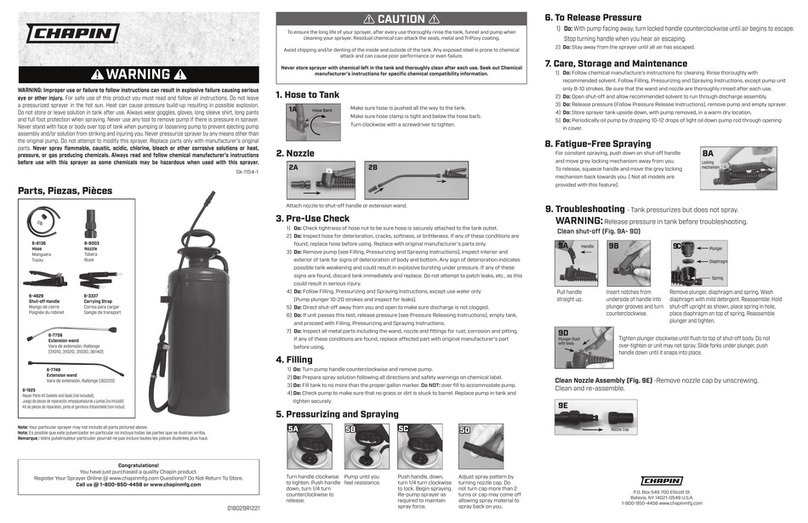
Chapin
Chapin 31430 User manual
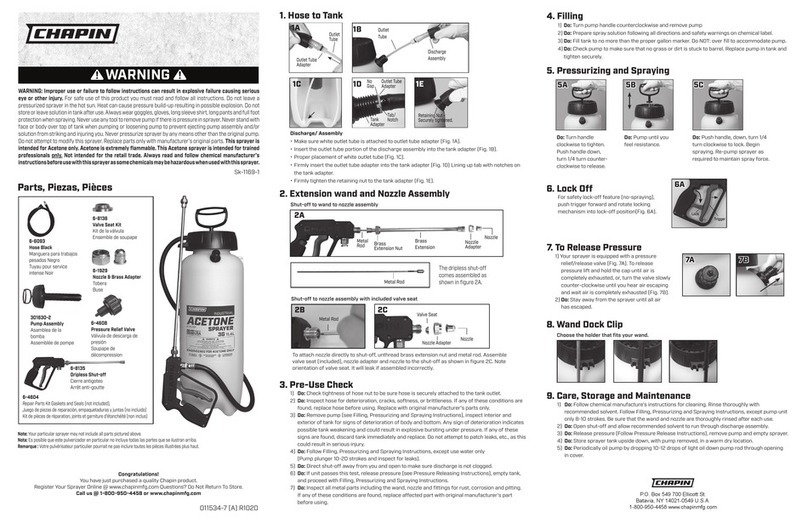
Chapin
Chapin Sk-1169-1 User manual
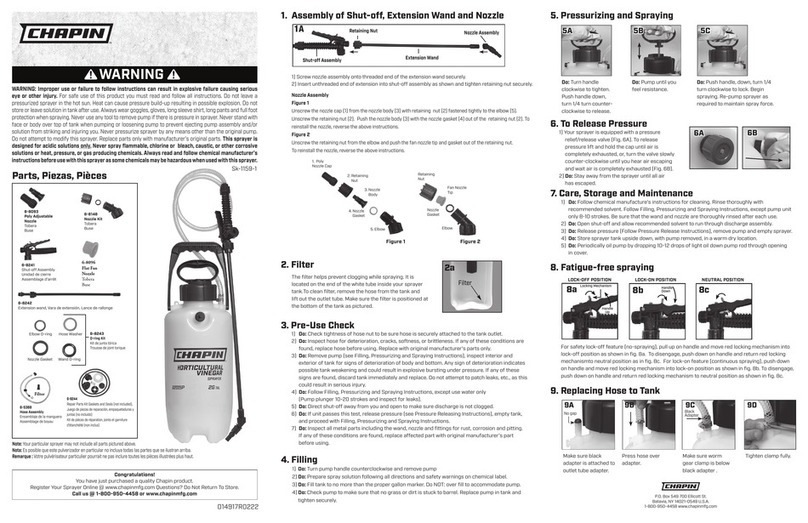
Chapin
Chapin Sk-1159-1 User manual
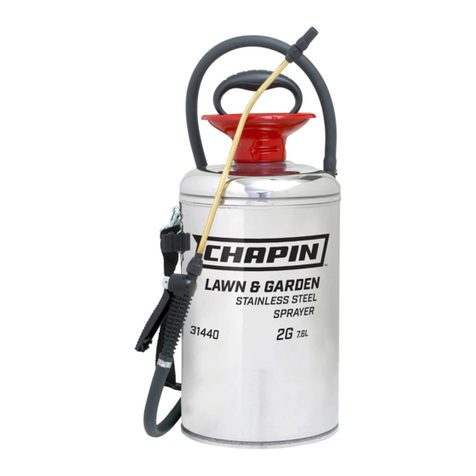
Chapin
Chapin 31440 User manual

Chapin
Chapin Commercial DUTY 63900 User manual

Chapin
Chapin 97500B Parts list manual

Chapin
Chapin 19099 User manual

Chapin
Chapin 97902 User manual
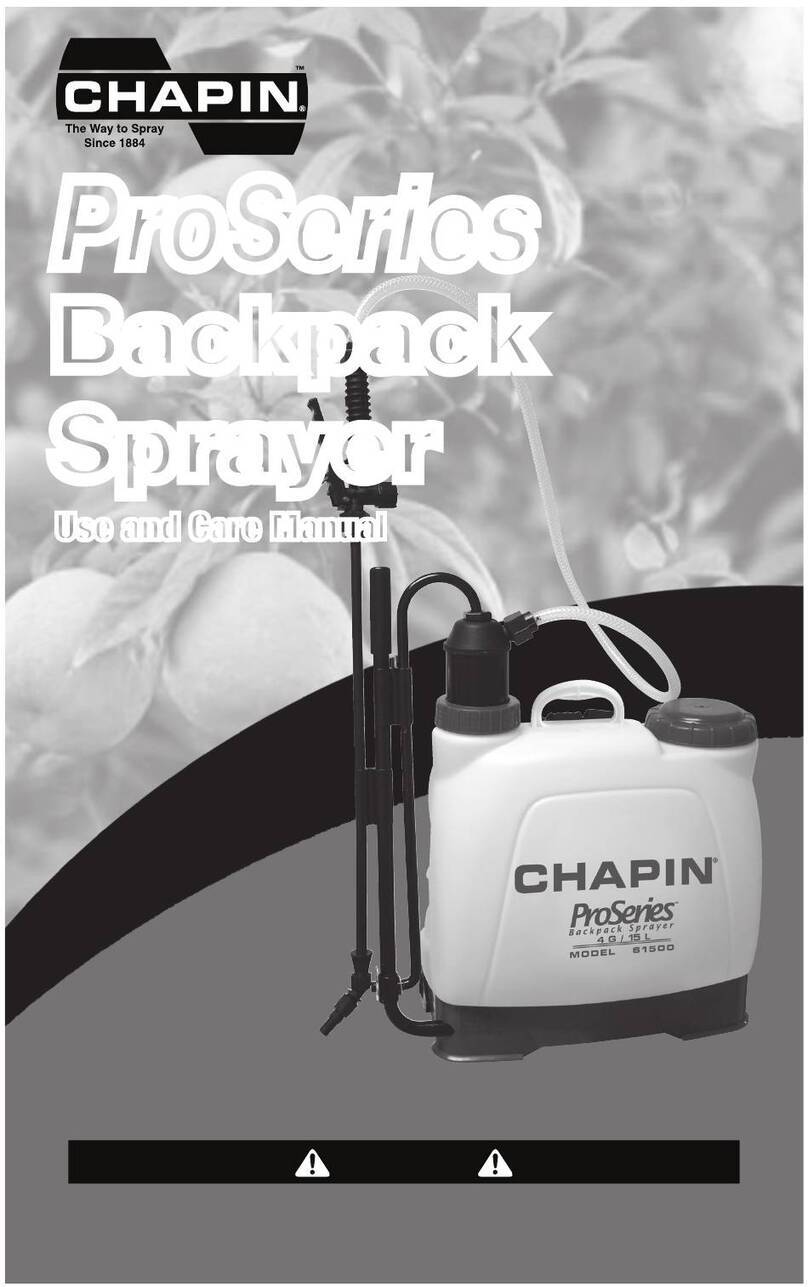
Chapin
Chapin Pro Series User manual
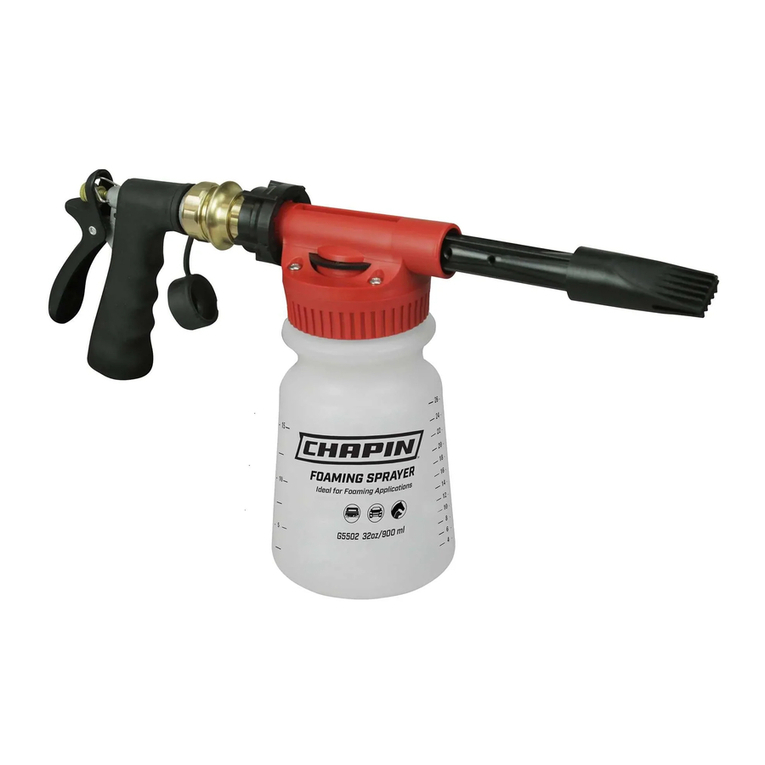
Chapin
Chapin G5502 User manual
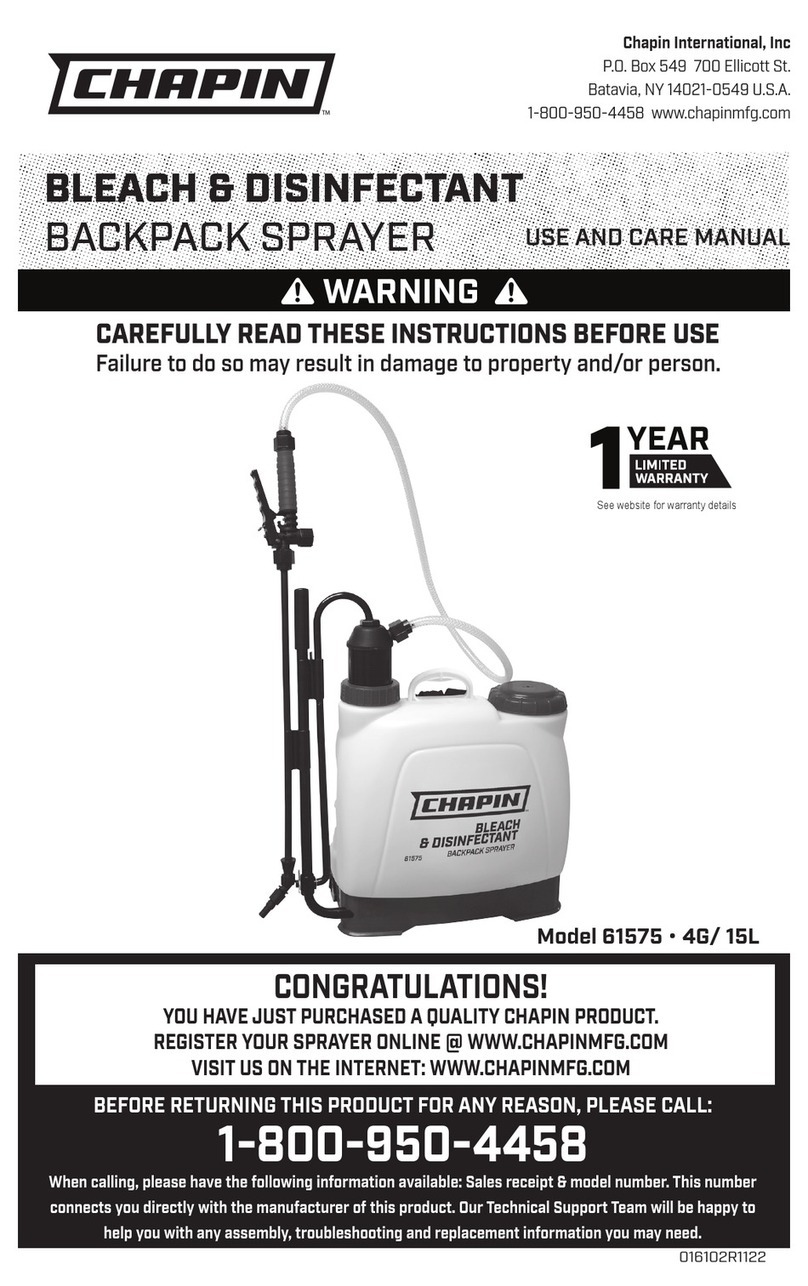
Chapin
Chapin BLEACH & DISINFECTANT User manual
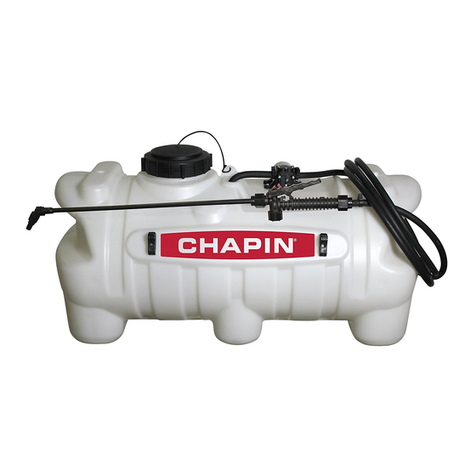
Chapin
Chapin 97400 Parts list manual
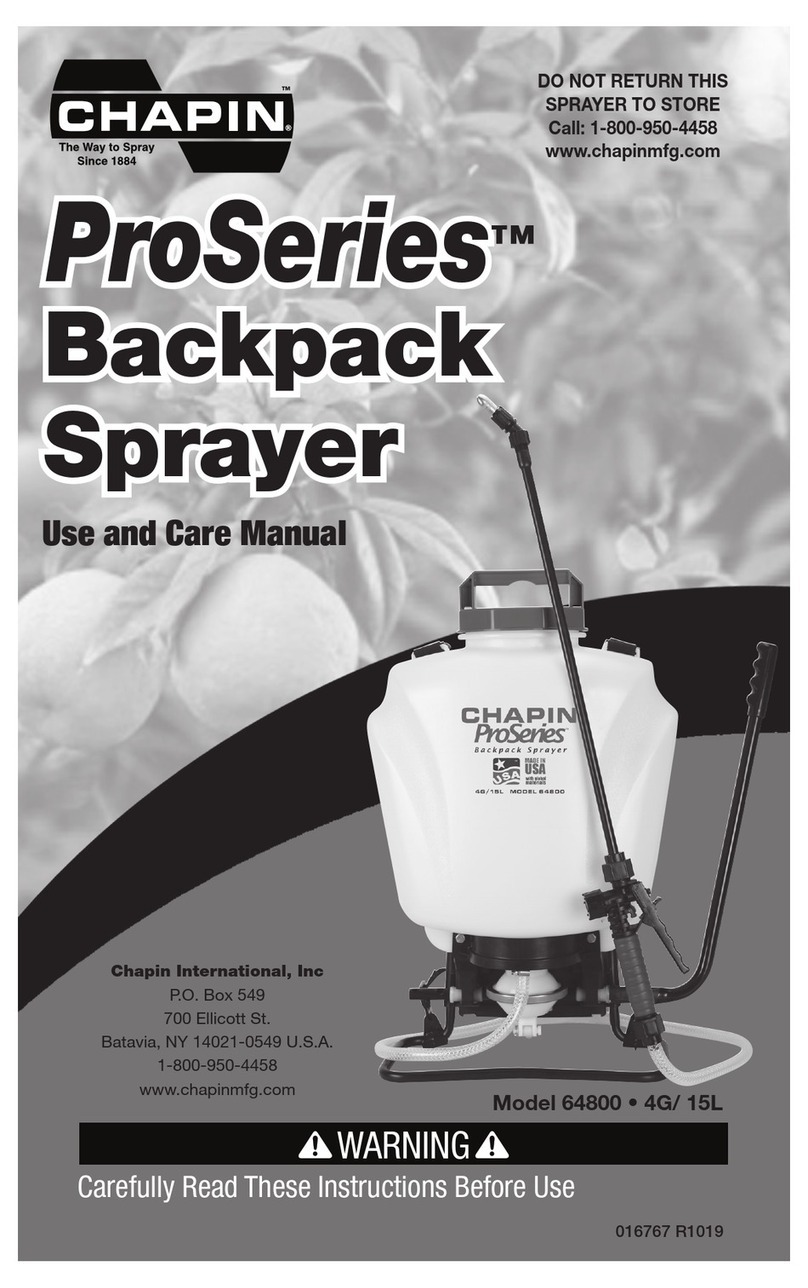
Chapin
Chapin Pro Series User manual

Chapin
Chapin 60100 User manual
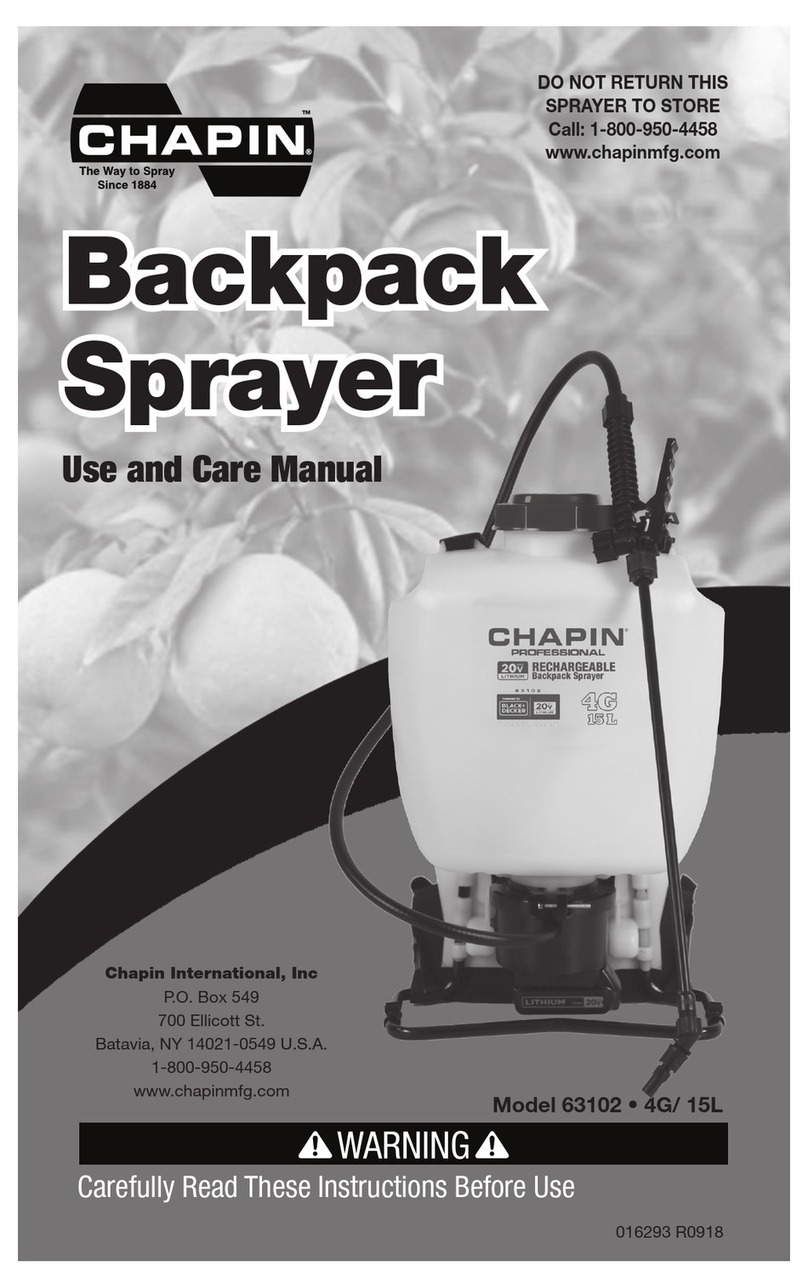
Chapin
Chapin 63102 User manual
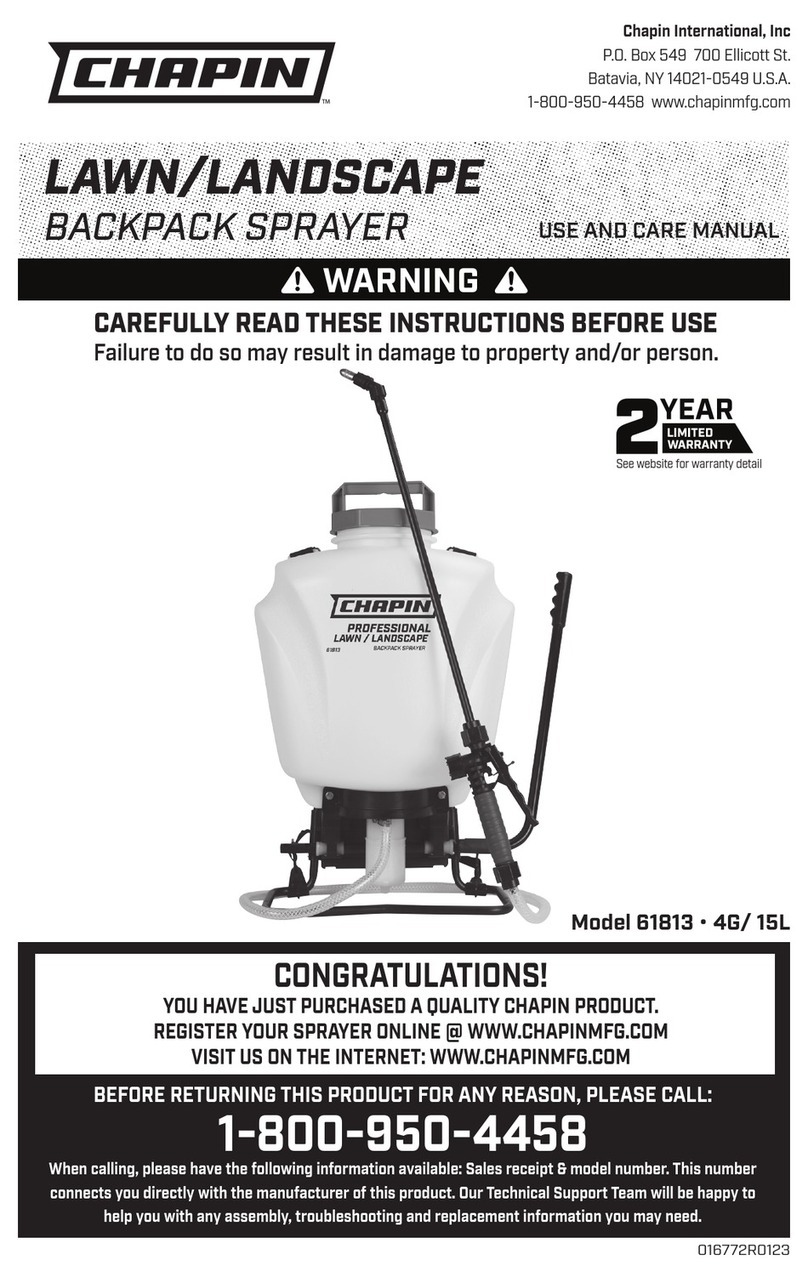
Chapin
Chapin 61813 User manual
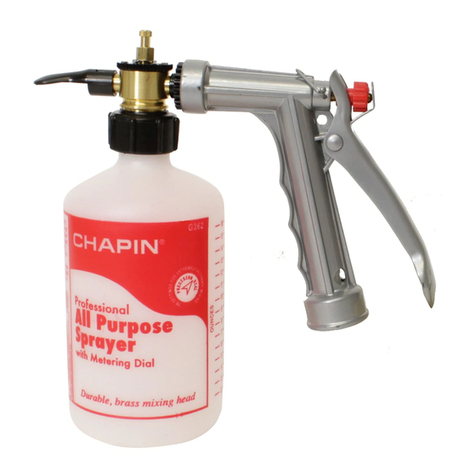
Chapin
Chapin G362 Product manual

Chapin
Chapin 61800 User manual

Chapin
Chapin 1949 User manual
